Georgia offers a delightful glimpse into the world of hummingbirds. From the vibrant Ruby-throated Hummingbird to rare vagrants like the Mexican Violetear, the state hosts a fascinating array of these tiny aerial acrobats. These birds captivate with their jewel-toned feathers, rapid wingbeats, and remarkable feeding habits. Understanding the types of hummingbirds in Georgia enhances birdwatching experiences and backyard wildlife observation. In this guide, we explore 13 species, detailing identification, behavior, habitat, diet, reproduction, and interactions with humans.
1. Ruby-throated Hummingbird (Archilochus colubris)

Physical Characteristics & Identification Tips
The Ruby-throated Hummingbird is a familiar sight in Georgia, measuring 3–3.5 inches in length. Males flaunt a brilliant ruby-red throat and iridescent green back, while females are duller with pale underparts. Key identification features include the forked tail and slender bill adapted for nectar feeding.
Behavior and Nesting Habits
These hummingbirds are highly territorial, often defending feeding sites vigorously. Males perform intricate courtship dives. Females build tiny cup-shaped nests using plant fibers and spider silk, camouflaged on tree branches or shrubs.
Habitat and Range
Ruby-throated Hummingbirds inhabit woodlands, forest edges, gardens, and flowering landscapes throughout Georgia. They migrate between the eastern U.S. and Central America, appearing in spring and late summer.
Diet
They feed primarily on nectar from tubular flowers, supplemented by small insects and spiders for protein. Garden feeders with sugar water are commonly visited.
Reproduction and Life Cycle
Females lay 1–3 tiny eggs per clutch, incubated for about 14–16 days. Hatchlings fledge after 18–22 days, remaining dependent on the mother briefly for feeding.
Fun Facts / Unique Traits
Despite their tiny size, they can migrate non-stop across the Gulf of Mexico. Their hovering technique and wingbeats, up to 53 times per second, make them true marvels of flight.
Human Interaction
Backyard feeders, native flowers, and water features attract these birds. Observers often enjoy watching their aerial acrobatics up close.
2. Rufous Hummingbird (Selasphorus rufus)

Physical Characteristics & Identification Tips
The Rufous Hummingbird is slightly smaller than the Ruby-throated, with males sporting a bright orange-red back and throat, and females displaying green backs and pale underparts. Their tail feathers often have white tips, assisting identification.
Behavior and Nesting Habits
These birds are known for their feisty and territorial behavior, chasing rivals aggressively. Females build small nests using moss, plant fibers, and spider silk, typically in sheltered shrubs or trees.
Habitat and Range
Primarily breeding in the Pacific Northwest, Rufous Hummingbirds appear as rare migrants in Georgia. They favor open woodlands, forest edges, and flowering gardens when visiting.
Diet
Their diet centers on nectar, supplemented with insects for essential protein. They are frequent visitors to hummingbird feeders during migration.
Reproduction and Life Cycle
Females lay 2 eggs per clutch, with incubation around 14 days. Hatchlings fledge in approximately three weeks.
Fun Facts / Unique Traits
These hummingbirds hold the record for longest migration relative to body size, traveling from Alaska to Mexico. Their aggressive nature is notable even among hummingbirds.
Human Interaction
Gardeners may attract Rufous Hummingbirds with tubular flowers and feeders. Sightings are considered special, as they are not common residents in Georgia.
3. Black-chinned Hummingbird (Archilochus alexandri)

Physical Characteristics & Identification Tips
Black-chinned Hummingbirds measure around 3 inches. Males exhibit a black throat with a violet base, grayish-green back, and white underparts. Females are more subdued with gray throats and lighter backs. The thin bill and slightly forked tail aid identification.
Behavior and Nesting Habits
These hummingbirds are moderately territorial and often forage near feeders or flowering shrubs. Females construct delicate cup-shaped nests on horizontal branches using plant fibers and spider silk.
Habitat and Range
Native to western North America, Black-chinned Hummingbirds are occasional vagrants in Georgia. They prefer open woodlands, gardens, and riparian edges during migration.
Diet
Primarily nectarivorous, they also consume small arthropods for protein. Feeders with sugar water can supplement their diet during northern visits.
Reproduction and Life Cycle
Clutches usually consist of 2 eggs, incubated for around 14 days. Chicks fledge in three weeks, staying near the mother for continued feeding.
Fun Facts / Unique Traits
These hummingbirds can enter torpor during cold nights to conserve energy. Their rare presence in Georgia makes any observation notable for birdwatchers.
Human Interaction
Occasionally attracted to backyard feeders and native flowering plants. Observers enjoy spotting them due to their scarcity in the region.
4. Calliope Hummingbird (Selasphorus calliope)

Physical Characteristics & Identification Tips
The Calliope Hummingbird is the smallest bird in North America, measuring just 3 inches. Males display a striking magenta throat with iridescent streaks, a green back, and white underparts. Females are muted, with greenish backs and pale throats. Look for their short, slightly rounded tail and tiny size when identifying in Georgia.
Behavior and Nesting Habits
Calliope Hummingbirds are feisty and agile, defending feeding territories vigorously despite their size. Females construct delicate cup-shaped nests using moss, plant fibers, and spider silk on slender tree branches.
Habitat and Range
Native to the western U.S., Calliope Hummingbirds occasionally appear in Georgia as rare migrants. They prefer open woodlands, forest edges, and flowering gardens when traveling through the region.
Diet
They feed primarily on nectar from tubular flowers, supplemented by tiny insects and spiders. Backyard feeders can be valuable food sources during migration.
Reproduction and Life Cycle
Females lay two eggs per clutch, with an incubation period of 14–16 days. Hatchlings fledge after about three weeks and remain dependent on the mother briefly afterward.
Fun Facts / Unique Traits
Calliope Hummingbirds have the distinction of being the smallest bird in North America. Despite their tiny size, they undertake long migratory journeys to Mexico.
Human Interaction
These hummingbirds may visit backyard feeders or native flowering shrubs if encountered during migration. Birdwatchers prize sightings due to their rarity in Georgia.
5. Allen’s Hummingbird (Selasphorus sasin)
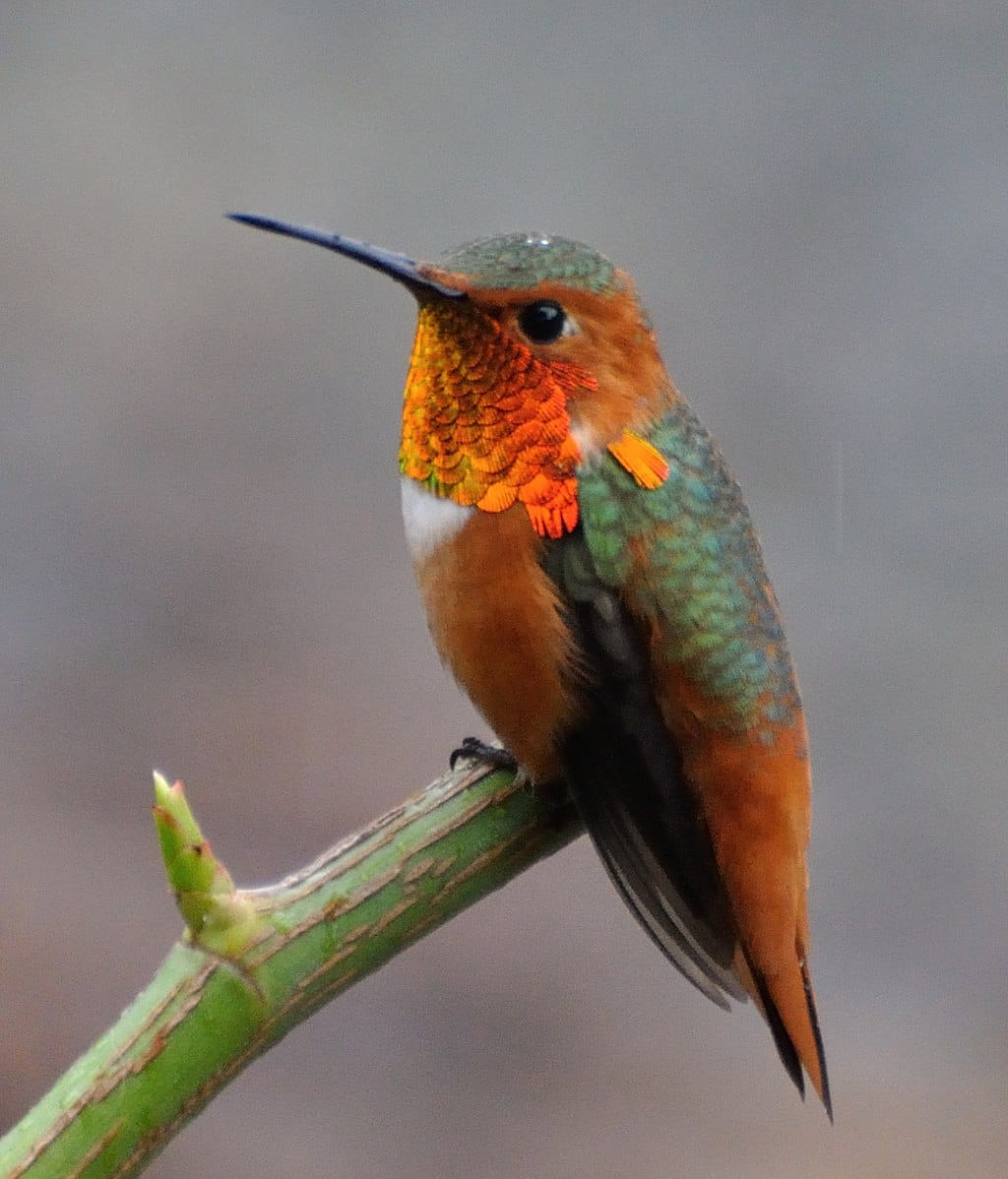
Physical Characteristics & Identification Tips
Allen’s Hummingbirds measure roughly 3–3.5 inches. Males have bright orange backs, rufous flanks, and a reddish-orange throat, while females are less colorful with green backs and pale underparts. Their slightly rounded tail and wing shape help distinguish them from similar species.
Behavior and Nesting Habits
These hummingbirds are bold and highly territorial around feeders and nectar sources. Females build compact cup-shaped nests on sheltered branches using plant fibers and spider silk.
Habitat and Range
Primarily found on the West Coast, Allen’s Hummingbirds appear rarely in Georgia as vagrants. They are adaptable to gardens, woodland edges, and areas with abundant flowering plants.
Diet
Their diet includes nectar from tubular flowers and small insects for protein. Backyard feeders can attract them when they stray far from their usual range.
Reproduction and Life Cycle
Females lay two eggs per clutch, incubated for about 14 days. Chicks fledge in roughly three weeks and are cared for by the mother for a short duration afterward.
Fun Facts / Unique Traits
Allen’s Hummingbirds are known for their energetic feeding and territorial behaviors. Their long migratory patterns occasionally bring them to unexpected locations like Georgia.
Human Interaction
Occasional visitors to feeders and flowering gardens, Allen’s Hummingbirds are considered special finds for birdwatchers in Georgia.
6. Broad‑tailed Hummingbird (Selasphorus platycercus)
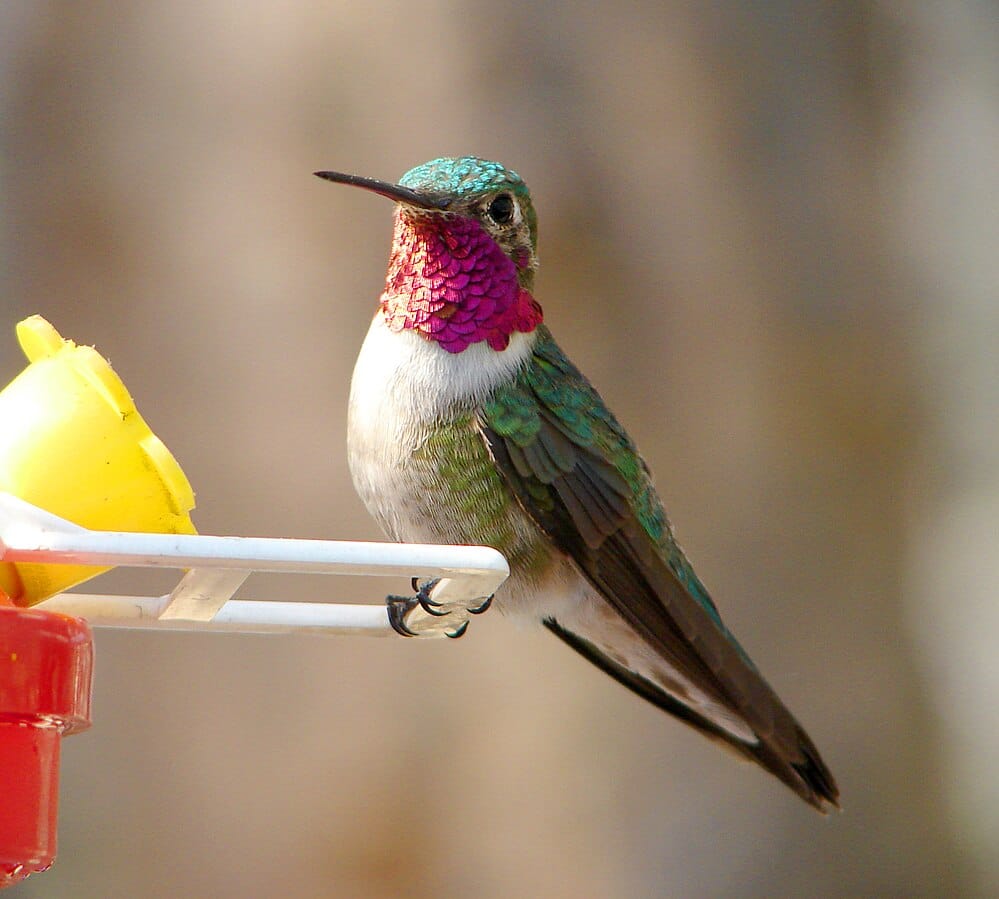
Physical Characteristics & Identification Tips
Broad-tailed Hummingbirds measure about 3.5 inches. Males display a rose-red throat, green back, and coppery flanks, while females are more subdued with pale underparts. Their broad, slightly forked tail distinguishes them from other small hummingbirds in Georgia.
Behavior and Nesting Habits
Known for their hovering and feeding agility, Broad-tailed Hummingbirds defend territories at abundant nectar sources. Females build delicate cup-shaped nests using soft plant fibers and spider silk on tree branches or shrubs.
Habitat and Range
Native to western U.S. mountains, Broad-tailed Hummingbirds appear rarely in Georgia during migration. They favor open woodlands, forest edges, and flowering gardens when traveling eastward.
Diet
Their diet consists primarily of nectar, supplemented with tiny insects and spiders. Sugar water feeders can provide a temporary food source for vagrant individuals.
Reproduction and Life Cycle
Clutches typically include two eggs, incubated for 14–16 days. Hatchlings fledge after roughly three weeks, receiving maternal care during early development.
Fun Facts / Unique Traits
These hummingbirds are known for their strong, rapid wingbeats and hovering displays. Their occasional appearance in Georgia excites local birdwatchers.
Human Interaction
Broad-tailed Hummingbirds may visit feeders and gardens during migration. Sightings are uncommon and highly valued among enthusiasts.
7. Broad‑billed Hummingbird (Cynanthus latirostris)
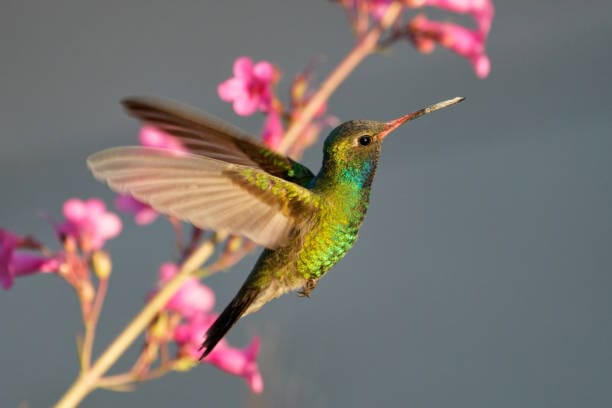
Physical Characteristics & Identification Tips
The Broad‑billed Hummingbird measures about 3.5 inches. Males feature a brilliant turquoise-blue throat, metallic green back, and a vivid red bill with a black tip. Females are more muted with grayish throats and green backs. Identification is aided by the bright bill and iridescent throat of males, which stands out even in the lush greenery of Georgia gardens.
Behavior and Nesting Habits
Broad‑billed Hummingbirds are highly active and agile fliers, defending feeding territories from intruders. Females construct small cup-shaped nests with plant fibers, moss, and spider silk, typically positioned on slender branches away from predators.
Habitat and Range
Native to the southwestern U.S. and Mexico, Broad‑billed Hummingbirds are rare vagrants in Georgia. They prefer arid canyons, desert scrub, and gardens rich in nectar when traveling east.
Diet
Their diet includes nectar from tubular flowers and occasional small insects. Migratory or vagrant individuals often supplement their intake with sugar water from backyard feeders.
Reproduction and Life Cycle
Females lay two tiny eggs, incubated for about 14–16 days. Chicks fledge approximately three weeks after hatching, relying on the mother for care during early development.
Fun Facts / Unique Traits
Broad‑billed Hummingbirds are admired for their vivid bill and striking coloration. Their occasional visits to Georgia gardens offer a rare visual treat for birdwatchers.
Human Interaction
These hummingbirds may visit nectar feeders and flowering plants during migration. Gardeners and birders treasure sightings due to their uncommon appearance in Georgia.
8. Anna’s Hummingbird (Calypte anna)

Physical Characteristics & Identification Tips
Anna’s Hummingbirds are medium-sized at 3.9 inches. Males have a vivid iridescent red crown and throat, green back, and grayish underparts. Females are more subdued with green backs and pale throats. Identification focuses on the male’s striking red gorget and crown.
Behavior and Nesting Habits
These hummingbirds are bold, frequently feeding near humans. Females construct cup-shaped nests with plant fibers and spider silk on branches sheltered from the wind and predators.
Habitat and Range
Primarily a West Coast species, Anna’s Hummingbirds are rare visitors to Georgia. They adapt well to suburban gardens, parks, and areas abundant in nectar-producing flowers.
Diet
They consume nectar and small insects for protein. Backyard feeders with sugar water can attract these vagrant individuals during migration.
Reproduction and Life Cycle
Females lay two eggs per clutch, incubated for roughly 14 days. Hatchlings fledge around three weeks after hatching, remaining under maternal care for a short period.
Fun Facts / Unique Traits
Anna’s Hummingbirds are known for their territorial and fearless feeding behavior. Their rare appearances in Georgia delight local birdwatchers and gardeners.
Human Interaction
They often feed at backyard nectar stations and may tolerate close human observation. Gardeners find them charming additions to flower beds and feeders.
9. Buff‑bellied Hummingbird (Amazilia yucatanensis)
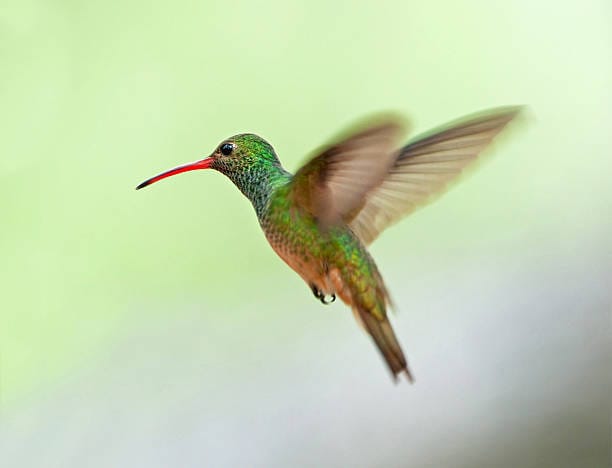
Physical Characteristics & Identification Tips
The Buff‑bellied Hummingbird measures about 3.5 inches. Males showcase a green back, blue-green throat, and buff-colored belly, while females are similar but less vibrant. Identification in Georgia focuses on the buff belly and subtle metallic throat colors.
Behavior and Nesting Habits
These hummingbirds are energetic fliers, often hovering near flowers or feeders. Females build small, cup-shaped nests from plant fibers and spider silk on low branches.
Habitat and Range
Native to the Gulf Coast and parts of Mexico, Buff‑bellied Hummingbirds appear occasionally in Georgia as rare vagrants. They favor coastal scrub, open woodland, and gardens during migration.
Diet
They primarily feed on nectar from tubular flowers and supplement with small insects. Backyard feeders provide important resources for migratory or wandering individuals.
Reproduction and Life Cycle
Clutches include two eggs, incubated for approximately 14–16 days. Hatchlings fledge around three weeks and remain under maternal care during early development.
Fun Facts / Unique Traits
Buff‑bellied Hummingbirds are admired for their soft buff-colored belly and quiet charm. Their rare presence in Georgia makes them a highlight for regional birdwatching enthusiasts.
Human Interaction
Gardeners and birders can attract them with feeders and flowering shrubs. Sightings in Georgia are uncommon, making them prized for photography and observation.
10. Rivoli’s (Magnificent) Hummingbird (Eugenes fulgens)
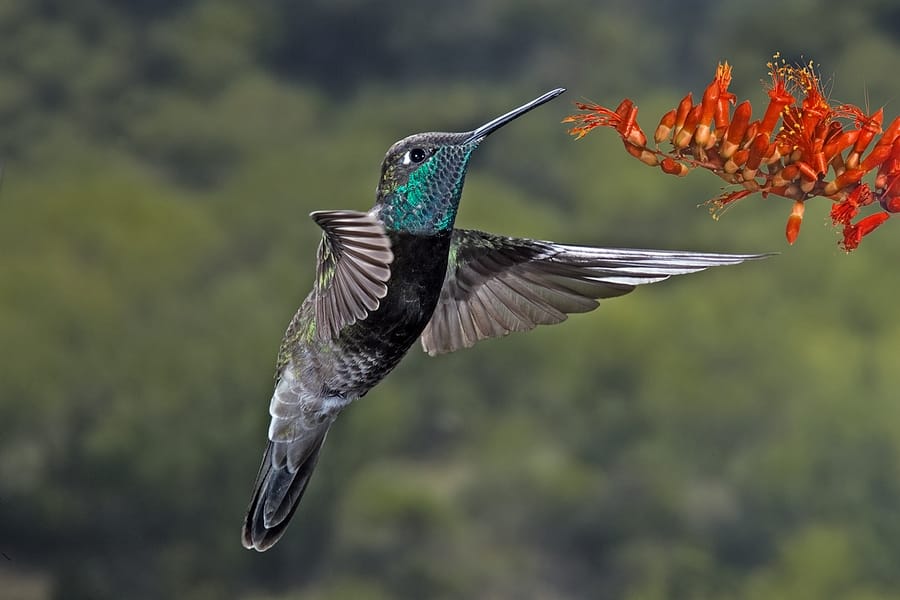
Physical Characteristics & Identification Tips
Rivoli’s Hummingbird is one of the largest North American hummingbirds, measuring approximately 4 inches. Males display a striking emerald-green back, violet-blue gorget, and white underparts. Females are smaller with paler throats and green backs. Key identification traits include the broad tail with subtle white tips and the iridescent throat that catches light beautifully.
Behavior and Nesting Habits
Rivoli’s Hummingbirds are strong fliers, hovering skillfully while feeding. Males are territorial, performing dramatic aerial displays to attract females. Nests are small cups made of plant fibers and spider silk, typically placed in protected locations on tree branches.
Habitat and Range
Native to mountainous regions from the southwestern U.S. to Central America, Rivoli’s Hummingbirds are rare vagrants in Georgia. They prefer pine-oak forests and woodland edges in their natural range, often at elevations of 4,000–8,000 feet.
Diet
The diet is primarily nectar from tubular flowers, supplemented by small insects and spiders. Visiting feeders can provide critical nourishment during unusual northern appearances.
Reproduction and Life Cycle
Females lay two eggs per clutch in a compact nest. Incubation lasts about 14–16 days, and chicks fledge roughly three weeks after hatching.
Fun Facts / Unique Traits
These hummingbirds are noted for their impressive size and vivid gorget. Their rare sightings in Georgia make them a prized target for birdwatchers.
Human Interaction
Occasionally visiting nectar feeders, they delight birders and gardeners who spot them outside their usual range.
11. Mexican Violetear (Colibri thalassinus)

Physical Characteristics & Identification Tips
The Mexican Violetear measures 4–4.5 inches and boasts iridescent green plumage with violet patches on the throat and sides of the neck. Males are more brightly colored than females, whose tones are slightly muted. Identification relies on the vivid violet ear patches and sizable wingspan.
Behavior and Nesting Habits
These hummingbirds are agile and fast, defending nectar sources from other birds. Nesting involves crafting a small cup from plant material and spider silk, often attached to thin, well-hidden branches.
Habitat and Range
Native to Central America, Mexican Violetears are rare vagrants in Georgia. They usually inhabit forests, gardens, and woodland edges, favoring areas with abundant flowering plants.
Diet
They feed primarily on nectar and occasionally small insects. Backyard feeders can attract wandering individuals during migration events or unusual weather patterns.
Reproduction and Life Cycle
Females lay two eggs, incubated for about two weeks. Chicks fledge roughly three weeks after hatching.
Fun Facts / Unique Traits
The species is admired for its large size and striking violet ear patches. Its rarity in Georgia makes every sighting notable for local birding communities.
Human Interaction
They can visit backyard feeders if provided with fresh nectar. Birdwatchers are often thrilled to observe these uncommon visitors in the state.
12. Blue‑throated Mountain‑gem (Lampornis clemenciae)
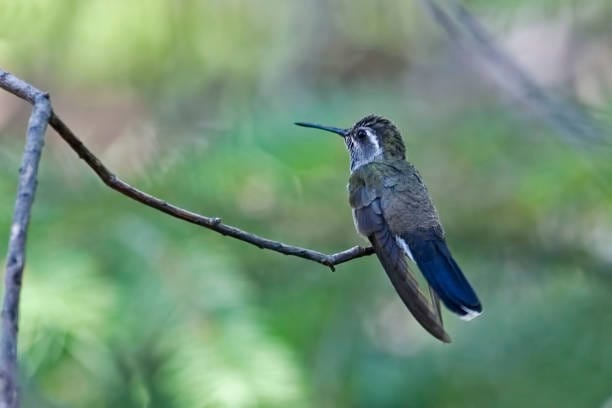
Physical Characteristics & Identification Tips
This large hummingbird measures 4.3–4.5 inches, with males featuring iridescent blue throats and metallic green bodies. Females are less colorful with green backs and pale underparts. Identification focuses on the vivid blue throat patch of males.
Behavior and Nesting Habits
Blue‑throated Mountain-gems are strong, deliberate fliers, often patrolling feeding territories. Nests are built by females on protected branches, composed of plant fibers and spider silk.
Habitat and Range
Native to mountainous areas in Mexico and the southwestern U.S., they are rare vagrants in Georgia. They favor pine-oak forests and high-elevation woodland habitats.
Diet
They feed on nectar from large, tubular flowers and small insects for protein. Visiting feeders can be a rare but important food source for vagrants.
Reproduction and Life Cycle
Females lay two eggs, incubated for approximately 14 days. Chicks fledge in about three weeks, remaining under maternal care initially.
Fun Facts / Unique Traits
Blue‑throated Mountain-gems are among the largest hummingbirds in North America. Their occasional presence in Georgia excites birdwatchers due to the rarity.
Human Interaction
They may visit feeders or flowering gardens. Observers treasure these sightings as extraordinary events in Georgia’s birding records.
13. Green‑breasted Mango (Anthracothorax prevostii)
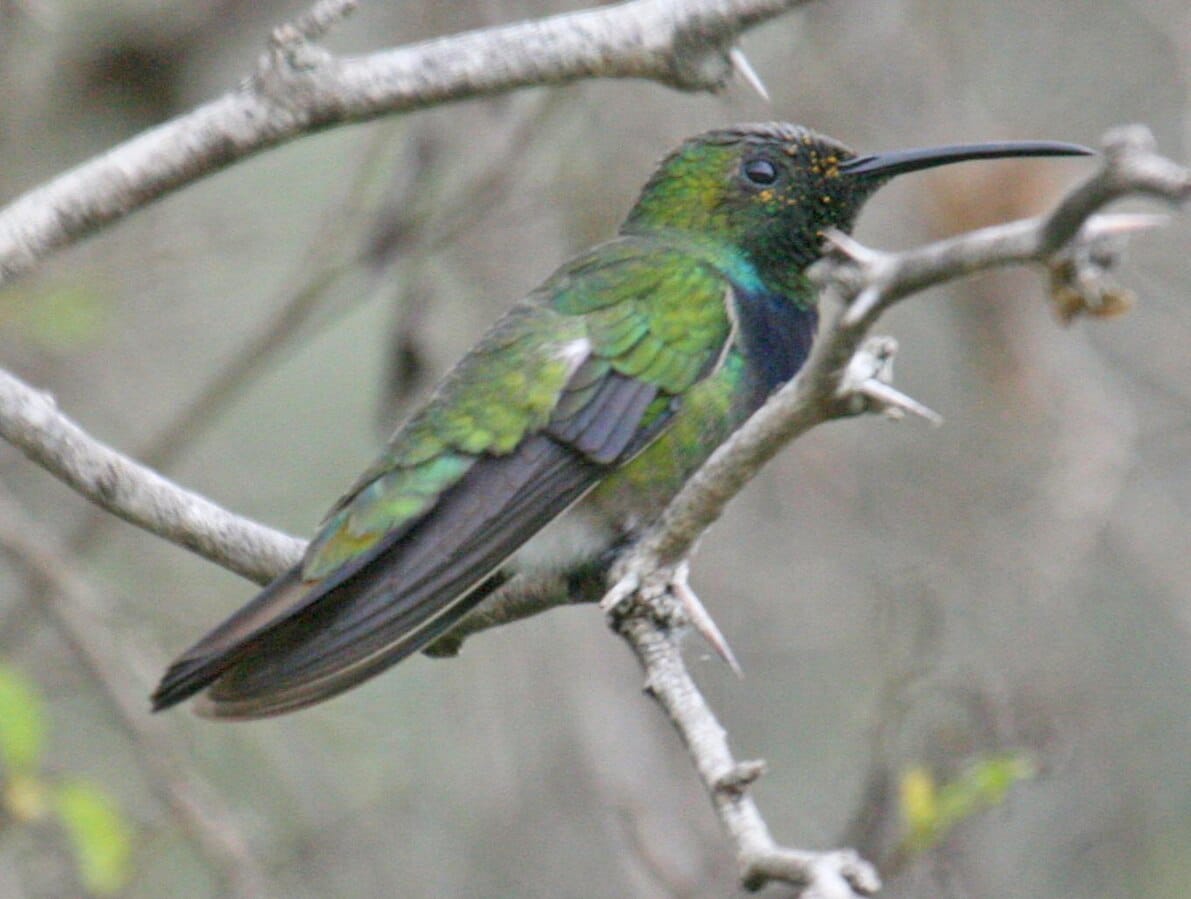
Physical Characteristics & Identification Tips
The Green‑breasted Mango is about 4.3 inches long, with glossy green upperparts and a reddish belly. Males have a slightly brighter chest than females. Identification is aided by the reddish belly contrasting with metallic green plumage.
Behavior and Nesting Habits
These hummingbirds are energetic, often chasing competitors from rich nectar sources. Females build cup-shaped nests from plant fibers and spider silk, usually positioned on sturdy branches.
Habitat and Range
Native to Central America and parts of Mexico, Green‑breasted Mangos are very rare in Georgia. They prefer forest edges, gardens, and areas abundant in nectar during rare excursions northward.
Diet
Their diet is mainly nectar supplemented by insects. Backyard feeders occasionally support these vagrant individuals.
Reproduction and Life Cycle
Females lay two eggs per clutch, incubated for about two weeks. Chicks fledge after roughly three weeks, remaining under maternal care initially.
Fun Facts / Unique Traits
Green‑breasted Mangos are admired for their vibrant belly color and agility. Their rare sightings in Georgia provide memorable experiences for birdwatchers.
Human Interaction
Occasionally visiting feeders and gardens, they are highly prized by photographers and birding enthusiasts due to their rarity in the state.
Comparison Table of 13 Hummingbirds in Georgia
| # | Species | Size (inches) | Key Identification Features | Behavior / Nesting | Habitat / Range in Georgia | Diet | Human Interaction |
|---|---|---|---|---|---|---|---|
| 1 | Ruby-throated Hummingbird | 3–3.5 | Males: red throat, green back; Females: green back, white underparts | Territorial, aggressive at feeders; nests in trees/shrubs | Throughout Georgia, especially gardens and forest edges | Nectar, insects, spiders | Common at backyard feeders; widely welcomed by birders |
| 2 | Calliope Hummingbird | 3 | Smallest North American hummingbird; males with streaked magenta throat | Hover feeders frequently; nest in shrubs or small trees | Occasional migrant sightings in northern and central Georgia | Nectar, insects | Rarely visits feeders, prized sighting for enthusiasts |
| 3 | Allen’s Hummingbird | 3–3.5 | Males: bright orange-red throat, green back; females duller | Active, territorial; nests in low shrubs | Rare migrant; mostly southern Georgia | Nectar, insects | Occasional feeder visitor, draws attention when spotted |
| 4 | Broad-tailed Hummingbird | 3.5–4 | Males: rose-red throat, bronze-green back; females: green back, whitish belly | Hovering for long periods; nests in conifers or low shrubs | Rare, primarily western and northern Georgia during migration | Nectar, small insects | Infrequent backyard visitor, often noted by birders |
| 5 | Broad-billed Hummingbird | 3.5 | Bright red bill with black tip; males with turquoise throat | Agile feeder; nests in shrubs or small trees | Very rare; occasional southern Georgia sightings | Nectar, insects | Highly sought-after sighting for bird watchers |
| 6 | Anna’s Hummingbird | 3.9–4 | Males: iridescent emerald-green, rose-red crown and throat; females duller | Bold and aggressive; nests in shrubs near human habitation | Occasional vagrant in Georgia, often urban areas | Nectar, insects | Feeds at backyard feeders; interacts readily with humans |
| 7 | Buff-bellied Hummingbird | 3.5–3.7 | Males: green back, orange-buff belly; females duller | Hover feeders; nests low in shrubs | Rare; southern Georgia sightings along coastal areas | Nectar, small insects | Uncommon at feeders; exciting for local birders |
| 8 | Rivoli’s (Magnificent) Hummingbird | 4–4.5 | Males: iridescent green with violet-blue throat; females smaller | Territorial; nests in higher shrubs and small trees | Very rare in Georgia; scattered sightings mostly in southern regions | Nectar, insects | Exceptional backyard visitor; birders celebrate sightings |
| 9 | Mexican Violetear | 4.3–4.5 | Bright violet ear patch, green body, long bill | Hover feeder specialist; nests in protected trees | Vagrant; rare southern Georgia appearances | Nectar, insects | Highly prized for birdwatchers; extremely rare in Georgia |
| 10 | Blue-throated Mountain-gem | 4–4.5 | Males: blue throat, green back; females: pale throat and underparts | Hover feeders; nests on horizontal branches | Extremely rare; mostly southern Georgia | Nectar, small insects | Very rare; birders keep detailed records of sightings |
| 11 | White-eared Hummingbird | 3.5–4 | Green body with distinct white ear stripe | Feeding specialist; nests in shrubs | Rare vagrant; occasional sightings in Georgia | Nectar, insects | Exciting vagrant; attracts local birdwatchers |
| 12 | Green-breasted Mango | 4–4.5 | Shiny green body with coppery belly and long bill | Hover feeders; nests in small trees or shrubs | Very rare; primarily southern Georgia | Nectar, insects | Highly sought by enthusiasts; rarely seen in Georgia |
| 13 | Violet-crowned Hummingbird | 3.5–4 | Pale violet crown, green back, grayish underparts | Hover feeders; nests in small shrubs | Rare visitor; southern Georgia sightings | Nectar, small insects | Occasional feeder visitor; prized by birders |
Conclusion
Georgia hosts an intriguing variety of hummingbirds, from the common Ruby-throated Hummingbird to rare vagrants like the Green-breasted Mango and Blue-throated Mountain-gem. While some species are regular visitors during migration or breeding seasons, others appear sporadically, making every sighting a special experience for birdwatchers and nature enthusiasts. By providing nectar-rich flowers and feeders, residents can enjoy observing these energetic and colorful birds up close, while also supporting their crucial migration journeys.
Exploring the hummingbirds of Georgia offers insights into their fascinating behaviors, distinctive physical features, and diverse habitats. Whether in forests, suburban gardens, or along rivers and streams, these tiny marvels demonstrate remarkable agility, resilience, and beauty. Appreciating them not only enhances our connection with nature but also encourages conservation efforts, ensuring that hummingbirds continue to thrive across Georgia for generations to come.
Frequently Asked Questions About Hummingbirds in Georgia
1. What types of hummingbirds are commonly found in Georgia?
Georgia hosts a variety of hummingbirds, including Ruby-throated, Calliope, Allen’s, Anna’s, and occasional vagrants like the Green-breasted Mango.
2. When is the best time to see hummingbirds in Georgia?
Peak viewing is from late spring to early fall during migration and breeding periods in Georgia.
3. How many species of hummingbirds visit Georgia each year?
Typically, 10–13 species are observed regularly in Georgia, with occasional rare visitors.
4. Are Ruby-throated Hummingbirds the most common in Georgia?
Yes, Ruby-throated Hummingbirds are by far the most frequently seen hummingbirds in Georgia.
5. Can Calliope Hummingbirds be spotted in Georgia?
Calliope Hummingbirds are rare visitors in Georgia, mostly seen during migration.
6. What habitats do hummingbirds prefer in Georgia?
Hummingbirds in Georgia favor gardens, forest edges, woodlands, and areas with abundant flowering plants.
7. Do hummingbirds migrate through Georgia?
Yes, Georgia lies along the migration routes for many hummingbirds traveling between breeding and wintering grounds.
8. How can I attract hummingbirds to my Georgia backyard?
Plant native flowers, set up red feeders with sugar water, and provide water sources to attract hummingbirds in Georgia.
9. What flowers are best for hummingbirds in Georgia?
Trumpet vine, bee balm, columbine, cardinal flower, and honeysuckle are excellent choices for Georgia gardens.
10. Are Allen’s Hummingbirds rare in Georgia?
Yes, Allen’s Hummingbirds are occasional visitors and are less frequently seen in Georgia.
11. How do Anna’s Hummingbirds behave when in Georgia?
Anna’s Hummingbirds are bold and may feed at backyard feeders if available in Georgia.
12. Where in Georgia are Rivoli’s Hummingbirds most likely to appear?
Rivoli’s Hummingbirds are extremely rare in Georgia, usually in southern regions during unusual weather events.
13. Can Mexican Violetears survive winter in Georgia?
No, they are vagrants in Georgia and cannot survive cold winter months.
14. What is the diet of hummingbirds in Georgia?
They feed on nectar from flowers, supplemented with small insects and spiders for protein in Georgia.
15. How long do hummingbirds stay in Georgia during migration?
Migrating hummingbirds may remain a few days to a few weeks in Georgia depending on food availability and weather.
16. Are there hummingbird feeders recommended for Georgia homes?
Simple red feeders with sugar water are effective in Georgia; placing them near flowers increases visits.
17. Do hummingbirds in Georgia face threats from predators?
Yes, domestic cats, larger birds, and occasionally snakes can threaten hummingbirds in Georgia.
18. How can I identify different hummingbird species in Georgia?
Look at throat color, size, tail shape, and wing patterns; Ruby-throated males are easy to recognize in Georgia.
19. Are Blue-throated Mountain-gems ever seen in Georgia?
Blue-throated Mountain-gems are extremely rare and only appear as accidental visitors in Georgia.
20. How do hummingbirds in Georgia choose nesting sites?
Females select branches or shrubs in sheltered areas with abundant insects and flowers.
21. Can Broad-billed Hummingbirds be found in Georgia?
Broad-billed Hummingbirds are very rare vagrants in Georgia, usually seen during migration.
22. What are some fun facts about hummingbirds in Georgia?
Hummingbirds in Georgia can beat their wings over 50 times per second and some travel hundreds of miles during migration.
23. How do Georgia hummingbirds differ from those in neighboring states?
Species composition and migration timing vary slightly in Georgia due to local climate and habitats.
24. Do hummingbirds in Georgia prefer urban or rural areas?
They thrive in both, provided there are sufficient nectar sources and safe nesting sites in Georgia.
25. Are there organized hummingbird-watching events in Georgia?
Yes, birding clubs and wildlife organizations host annual hummingbird counts and garden tours in Georgia.
26. How can I photograph hummingbirds in Georgia effectively?
Use fast shutter speeds near feeders or flowers and be patient for hovering shots in Georgia.
27. What is the lifespan of hummingbirds in Georgia?
They can live up to 5 years, though migration and predators influence survival in Georgia.
28. How does climate change affect hummingbirds in Georgia?
Changes in flowering seasons, temperatures, and storms can impact migration and food availability in Georgia.
29. Are hummingbird populations in Georgia increasing or decreasing?
Populations fluctuate; habitat loss and climate factors affect numbers, but backyard feeding helps support hummingbirds in Georgia.
30. What are common behaviors of hummingbirds in Georgia?
They are territorial, agile fliers, and males often perform display dives during breeding in Georgia.
31. How do Georgia gardeners support hummingbird breeding?
Plant native nectar plants, provide safe nesting areas, and avoid pesticides to protect the insects they feed on.
32. Can hummingbirds in Georgia coexist with other nectar-feeding birds?
Yes, they may chase smaller competitors but generally share habitats with bees, butterflies, and other nectar feeders.
33. Are there state-specific guidelines for protecting hummingbirds in Georgia?
Georgia encourages planting native flowers, maintaining feeders, and monitoring bird populations through citizen science programs.
